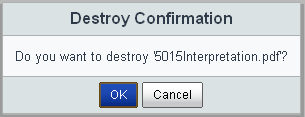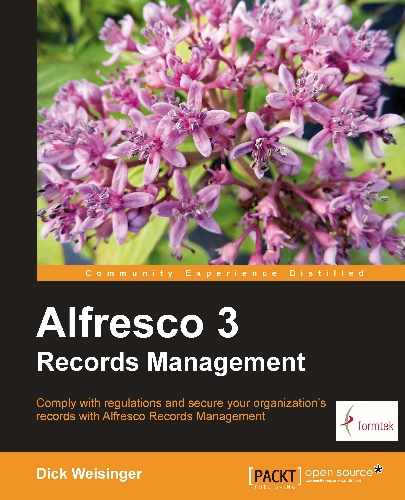- Alfresco 3 Records Management
- Alfresco 3 Records Management
- Credits
- About the Author
- About the Reviewer
- www.PacktPub.com
- Preface
- 1. Records Management
- What is a record?
- What is Records Management?
- Record lifecycles
- Benefits of Records Management
- Records Management is about complying with legal requirements
- Records Management is about ensuring accountability
- Records Management is about preserving assets
- Records Management is about efficiency
- Records Management is about being prepared
- Records Management is about coming to grips with data volumes
- Records Management is about security
- Records Management is about good business
- Summary
- What is a record?
- 2. Getting Started with the Alfresco Records Management Module
- The Alfresco stack
- Alfresco software
- How does it work?
- The Records Management AMP Files
- The Records Management Console dashlet
- The flow of Alfresco webscripts
- The flow of the Records Management webscript dashlet
- The Records Management dashlet files
- The Records Management dashlet files in the MVC Pattern
- The Records Management descriptor file
- The Records Management dashlet controller
- The Records Management dashlet view
- The Records Management dashlet URL
- The Records Management console client-side JavaScript
- Creation of the Records Management site
- Web development within Share
- Summary
- 3. Introduction to the Alfresco Share Records Management Site
- The Share environment
- The Records Management site
- How does it work?
- Share configuration files
- Dashboards
- Creating a new Share theme
- Share site top navigation toolbar
- Summary
- 4. Metadata and the Alfresco Content Model
- 5. Creating the File Plan
- The File Plan — a definition
- Best practice for creating the File Plan
- Creating the File Plan
- File Plan container metadata
- Copy and move of File Plan containers
- How does it work?
- Summary
- 6. Creating Disposition Schedules
- 7. Filing Records
- Filing — more than one way
- Filing an electronic record from Share
- Filing a non-electronic record from Share
- Filing from another Share site
- Filing a record from a CIFS mounted drive
- Filing from an e-mail client with IMAP
- Filing to Alfresco via FTP
- Bulk import
- Filing by scanning
- Other ways to file
- How does it work?
- Summary
- 8. Managing Records
- Records Details
- How does it work?
- The Details page
- The JavaScript controller for the Details page
- The FreeMarker template for the Details page
- The Details page
- Summary
- 9. Following the Lifecycle of a Record
- Undeclared records
- Specifying mandatory metadata
- Declaring the record
- Record review
- Closing a Folder
- Cutoff
- Transfer
- Accession
- Destruction
- Audit log
- Hold or freeze
- The File Plan report
- How does it work?
- Summary
- 10. Searching Records and Running Audits
- 11. Configuring Security and Permissions
- 12. Configuring Records Management Parameters
As we've seen earlier, Destruction is the last stage of a record lifecycle. After a record has been retained and is no longer needed or has been transferred from the repository to a new location, the document is available for destruction.
In the previous section on Accession, we looked at the example of a record that had destruction as the final step of its disposition, immediately after the record was transferred for accession.
If we select the Destroy action for a record that is available for destruction, we are presented with the following dialog:

After confirming that we would like to destroy the record, there is a second Confirmation screen:

After confirming a second time, the file contents of the record are deleted. With the file content for the record missing, just a stub entry for the record remains in the system. The stub still contains the complete metadata for the record and also all the audit history information that has been logged for the record. In the document list, the entry for the item shows a small status icon of a trash can and the thumbnail for the item is changed to a picture of an icon with an information mark, which indicates the record has been destroyed and the metadata is available for information only:

Note
Don't confuse Destroy and Delete actions. Delete permanently removes the record, including all metadata and audit information from the system. Destroy removes the file content from the record while maintaining a complete audit trail and metadata for the record, and marks the item with an icon as having been destroyed.
-
No Comment
